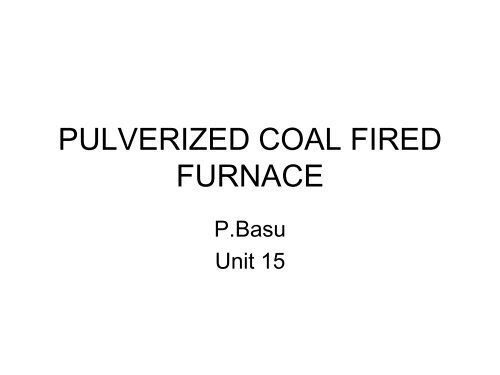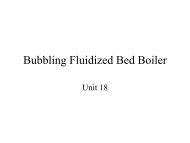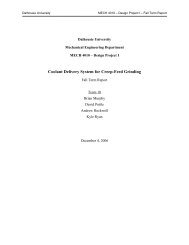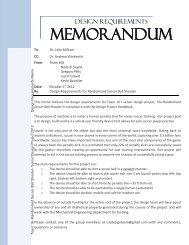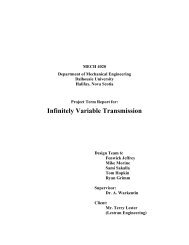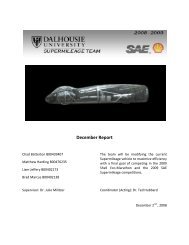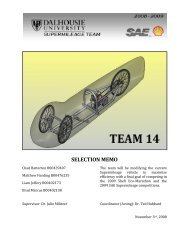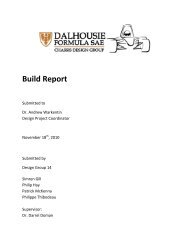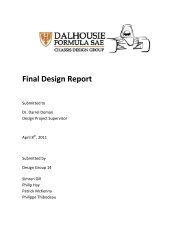PULVERIZED COAL FIRED FURNACE
PULVERIZED COAL FIRED FURNACE
PULVERIZED COAL FIRED FURNACE
You also want an ePaper? Increase the reach of your titles
YUMPU automatically turns print PDFs into web optimized ePapers that Google loves.
<strong>PULVERIZED</strong> <strong>COAL</strong> <strong>FIRED</strong><br />
<strong>FURNACE</strong><br />
P.Basu<br />
Unit 15
435 MWe<br />
tangential<br />
fired PF
A PF boiler plant
Oil/gas/<br />
PF fired<br />
furnace
Furnace size depends on Fuel<br />
Amount of flue gas, burning rate of fuel and slagging propensity also affects the furnace<br />
volume
Characteristic temperatures of ash
Burner locations in tangential PC
Axial heat flux in a PC furnace<br />
• The heat flux in mid-height is much more than<br />
elsewhere
Axial temperature distribution in PC
Isothermal in<br />
PC furnace<br />
• Highest<br />
temperature<br />
is 2000 0<br />
• Considerable<br />
temperature<br />
non<br />
uniformity in<br />
furnace
Heat release rates<br />
• Volumetric heat release rate<br />
q<br />
v<br />
B LHV<br />
V<br />
B= kg/s fuel burnt<br />
• Grate heat release rate<br />
B. LHV<br />
kW/m 3<br />
q F = kW/m 2<br />
F grate<br />
B. LHV = Heat released in furnace in kW
Furnace volume is shown by<br />
hatched area
Typical values of Vol. Heat release rate, q v<br />
Coal Type Dry-bottom<br />
furnace<br />
MW/m 3<br />
Anthracite 0.110-0.140<br />
Semi<br />
anthracite 0.116-0.163<br />
Bituminous 0.14-0.20<br />
Lignite 0.09-0.15<br />
Oil 0.23-0.35 Grate release<br />
rate<br />
Grate<br />
velocity<br />
Biomass 0.176 1.5-3.5 MW t /m 2 6.1m/s<br />
Gas 0.35
Upper limits of Average Grate heat release rate, q F<br />
Boiler<br />
capacity<br />
Upper limit of q F in MW/m2<br />
(ST= Softening Temperature)<br />
(tons/h)* ST 1300 C ST =1300 C ST 1300 C<br />
130 2.13 2.56 2.59<br />
220 2.79 3.37 3.91<br />
420 3.65 4.49 5.12<br />
500 3.91 4.65 5.44<br />
1000 4.42 5.12 6.16<br />
1500 4.77 5.45 6.63<br />
•One ton/h steam is roughly equivalent to 0.75 MWth heat input<br />
•To get the electrical power output (MWe) of the plant multiply heat input with (plant<br />
efficiency/100), which gives 1 t/h approx equal to 0.3 MWe.
Minimum depth of furnace<br />
It ensures that flame does not hit the wall facing the burner causing damage<br />
Boiler capacity<br />
(t/h)<br />
130 220 420 670 >670<br />
Coal (m) 6.0 7.0 7.5 8.0 (5-6)d r *<br />
Oil (m) 5.0 5.0 6.0 7.5 5<br />
d r *-maximum nozzle diameter of swirl burner<br />
Note: A square cross-section is good for tangential firing. However<br />
the depth must not be shallower than the above limit
Burner region heat release rate, q b<br />
q<br />
b<br />
B LHV<br />
2(<br />
a b) H<br />
b<br />
B.LHV = Furnace heat<br />
release in MW/m 2<br />
It ensures that the peak heat flux and temperature is not too<br />
high to cause dry out and other severe conditions in wall<br />
Fuel q b in MW/m 2<br />
Brown coal & Bituminous coal 0.93 -1.16<br />
Anthracite and semi-anthracite 1.4 - 2.1<br />
Lignite 1.4 - 2.32
Shortest distance between burner<br />
Boiler capacity<br />
(t/h)<br />
and Heating surface (H fu)<br />
It avoids any potential flame impingement on the Superheaters<br />
hanging from the wall, which might rupture the tubes<br />
65-75 130 220 420 670<br />
Anthracite (m) 8 11 13 17 18<br />
Bituminous (m) 7 9 12 14 17<br />
Oil (m) 5 8<br />
H fu is the height between top of the burner zone and superheater section
Furnace exit gas temperature (FEGT)<br />
• High FEGT makes the furnace compact but<br />
increases potential for fouling (coal firing) or<br />
corrosion (oil firing)<br />
• FEGT < 1250-1400 0 C for oil<br />
• FEGT < Lesser of Ash DT or (ST-100) C<br />
• Gas temp before Platen < 1100-1250 C<br />
• Gas temp. after platen
Q<br />
Heat transfer in furnace<br />
• Furnace heat absorbed, Q abs<br />
B(<br />
Q<br />
• FEGT is related to flame temperature<br />
Substitution yields<br />
I<br />
)<br />
BVC<br />
( T<br />
FEGT )<br />
F(<br />
T<br />
abs<br />
fu ou<br />
p th<br />
s<br />
4<br />
fl<br />
F- furnace surface area, ψ – fraction of flame radiation absorbed by surface, as –<br />
flame-wall emissivity, Tfl, Tfw – Temperature of flame and wall respectively<br />
asC<br />
B<br />
0<br />
fl<br />
4n<br />
ou<br />
T<br />
T<br />
fl<br />
th<br />
ou<br />
FEGT<br />
T<br />
1<br />
th<br />
0<br />
n<br />
n<br />
ou<br />
a<br />
T<br />
4<br />
fw<br />
)
Furnace heat transfer<br />
• From<br />
experimental<br />
results (a s~a fu)<br />
• From above we<br />
get heat transfer<br />
surface area, F<br />
• FEGT (T ou) from<br />
empirical relation<br />
ou 1 B0<br />
1 ou M<br />
a fu<br />
F<br />
a<br />
T<br />
fu<br />
ou<br />
B.<br />
q'<br />
M.<br />
T<br />
3<br />
th<br />
T<br />
ou<br />
T<br />
M.<br />
a<br />
th<br />
0.<br />
6<br />
fu<br />
0.<br />
6<br />
1<br />
M<br />
. B<br />
0.<br />
6<br />
0<br />
T<br />
T<br />
B<br />
th<br />
ou<br />
0.<br />
6<br />
0<br />
1<br />
0.<br />
66
Problem<br />
• Find the size of a dry bottom pulverized<br />
coal fired furnace to fire 19.8 kg/s medium<br />
bituminous coal having LHV of 18,289<br />
kJ/kg . Ash softening temperature is 1350<br />
C


